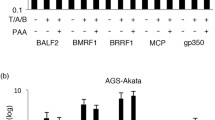Summary
We have characterized the properties of an Epstein-Barr virus vector (EBV-CMV) and compared its expression potential with a respective integrating vector (CMV). These vectors were used to express chloramphenicol acetyltransferase (CAT) gene in human HeLa, 293, monkey CV-1, dog MDCK, and hamster R 1610 cells. The EBV-CMV-cat DNA replicates extrachromosomally in HeLa, 293 and CV-1 cells, where also high expression of CAT gene was observed. The EBV-CMV vector integrated in MDCK and R 1610 cells and the CMV vector integrated in all cells tested. Integration yielded mostly clones with low CAT expression. In all cell lines, except HeLa cells, the existence of the extrachromosomal but not the integrated vector DNA is strictly dependent on the Hygromycin B selection pressure. The extrachromosomal state of the EBV vector is a prerequisite for good expression particularly in human and monkey cells.
Similar content being viewed by others
References
Allshire RC, Bostock CJ (1986) Structure of bovine papillomavirus type 1 DNA in a transformed mouse cell line. J Mol Biol 188: 1–13
Allshire RC, Bostock CJ (1986) Duplication of a viral enhancer sequence improves the stability of a vector based on BPV-1 DNA. Virus Res 6: 141–154
Bernard H-U, Oltersdorf T, Seedorf K (1987) Expression of the human papillomavirus type 18 E 7 gene by a cassette-vector system for the transcription and translation of open reading frames in eukaryotic cells. EMBO J 6: 133–138
Blochlinger K, Diggelman H (1984) Hygromycin B phospho-transferase as a selectable marker for DNA transfer experiments with higher eucaryotic cells. Mol Cell Biol 4: 2929–2931
Boshart M, Weber F, Jahn G, Dorsch-Häsler K, Fleckenstein B, Schaffner W (1985) A very strong enhancer is located upstream of an immediate early gene of human cytomegalovirus. Cell 41: 521–530
Bradford M (1976) A rapid and sensitive method for the quantitation of microgram quantities of protein utilizing the principle of protein-dye binding. Anal Biochem 72: 248–254
Foecking MK, Hofstetter H (1986) Powerful and versatile enhancer-promoter unit for mammalian expression vectors. Gene 45: 101–105
Gorman CM, Moffat LF, Howard BH (1982) Recombinant genomes which express chloramphenicol acetyltransferase in mammalian cells. Mol Cell Biol 2: 1044–1051
Hirt B (1967) Selective extraction of polyoma DNA from infected mouse cell cultures. J Mol Biol 26: 365–369
Jalanko A, Kallio A, Ruohonen-Lehto M, Söderlund H, Ulmanen I (1988) An EBV-based mammalian cell expression vector for efficient expression of cloned coding sequences. Biochim Biophys Acta 949: 206–212
Kioussis D, Wilson F, Daniels C, Leveton C, Taverne J, Playfair JHL (1987) Expression and rescuing of a cloned human tumour necrosis factor gene using an EBV-based shuttle cosmid vector. EMBO J 6: 355–361
Korpela K, Buchert P, Söderlund H (1987) Determination of plasmid copy number with nucleic acid sandwich hybridization. J Biotechnol 5: 267–277
Lupton S, Levine AS (1985) Mapping genetic elements of Epstein-Barr virus that facilitate extrachromosomal persistence of Epstein-Barr virus-derived plasmids in human cells. Mol Cell Biol 5: 2533–2542
Lupton S, Levine AJ (1986) Characterization of the genetic signals required for Epstein-Barr virus plasmid maintenance. In: Botchan M, Grozicker T, Sharp PA (eds) DNA tumor viruses. Control of gene expression and replication. Cold Spring Harbor Laboratory, New York (Cancer cells, vol 4, pp 543–553)
Lupton S, Chittenden T, Levine AJ (1987) Genetic elements of Epstein-Barr virus required for extrachromosomal persistence in cells. In: Miller JH, Calos MP (eds) Gene transfer vectors for mammalian cells. Cold Spring Harbor Laboratory, New York (Current communications in molecular biology, pp 57–63)
Maniatis T, Fritsch EF, Sambrook J (1982) Molecular cloning: a laboratory manual. Cold Spring Harbor Laboratory, New York
Rawlins DR, Rosenfeld PJ, Kelly TJ, Milman GR, Jeang K-T, Hayward SD, Hayward GS (1987) Sequence-specific interactions of cellular nuclear factor I and Epstein-Barr virus nuclear antigen with herpesvirus DNAs. In: Botchan M, Grozicker T, Sharp PA (eds) DNA tumor viruses. Control of gene expression and replication. Cold Spring Harbor Laboratory, New York (Cancer cells, vol 4, pp 525–542)
Reisman D, Yates J, Sudgen B (1985) A putative origin of replication of plasmids derived from Epstein-Barr virus is composed of two cis-acting components. Mol Cell Biol 5: 1822–1832
Ruohonen-Lehto M, Korpela K, Söderlund H, Ulmanen I (1987) Integration and integrity of a bovine papillomavirus expression vector in different mammalian cells. J Biotechnol 6: 91–105
Shimizu Y, Koller B, Geraghty D, Orr D, Shaw S, Kavathas P, DeMars R (1986) Transfer of cloned human class I major histocompatibility complex genes into HLA mutant human lymphoblastoid cells. Mol Cell Biol 6: 1074–1087
Sudgen B, Marsh K, Yates J (1985) A vector that replicates as a plasmid and can be efficiently selected in B-lymphoblasts transformed by Epstein-Barr virus. Mol Cell Biol 5: 410–413
Yates J, Warren N, Reisman D, Sudgen B (1984) A cis-acting element from the Epstein-Barr viral genome that permits stable replication of recombinant plasmids in latently infected cells. Proc Natl Acad Sci USA 81: 3806–3810
Yates JL, Warren N, Sudgen B (1985) Stable replication of plasmids derived from Epstein-Barr virus in various mammalian cells. Nature 313: 812–815
Young J, Cheadle C, Foulke JS, Drohan WN, Sarver N (1988) Utilization of an Epstein-Barr virus replicon as a eukaryotic expression vector. Gene 62: 171–185
Author information
Authors and Affiliations
Rights and permissions
About this article
Cite this article
Jalanko, A., Kallio, A. & Ulmanen, I. Comparison of mammalian cell expression vectors with and without an EBV-replicon. Archives of Virology 103, 157–166 (1988). https://doi.org/10.1007/BF01311089
Received:
Accepted:
Issue Date:
DOI: https://doi.org/10.1007/BF01311089




